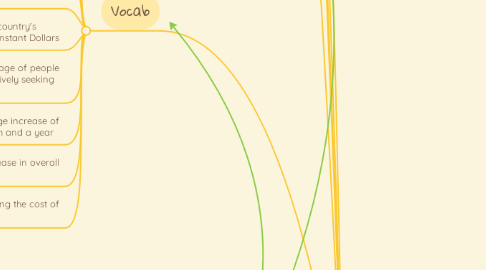
1. Vocab
1.1. Market Value- Price buyers are willing to pay for a good or service in a competitive market
1.2. Final Good- Any new good that is ready for consumer use
1.3. Intermediate Goods- Used in the production of a final good
1.4. Net Exports- Value of all exports minus all imports
1.5. Current Dollars- Value of an dollar the yea it was spent
1.6. Real GDP- A measurement a country's economic output valued in constant Dollars
1.7. Unemployment Rate- Percentage of people in the labor force who are actively seeking for work
1.8. Inflation Rate- The percentage increase of average prices from a month and a year
1.9. Demand pull inflation-Increase in overall demand
1.10. Cost push inflation- Increasing the cost of the factors of production
2. Limitations of GDP
2.1. Leaves out unpaid household and volunteer work- activites that are unpaid can have some value, but no money is exchanged therefore it doesn't register towards the GDP
2.2. Ignores informal and illegal exchanges-Statics do no not count informal or illegal activity towards the GDP
2.3. Counts some negatives as positives- If your GDP is higher it can be a bad thing
2.4. Ignores negative externalizes- Sometimes GDP doesn't reflect the negative externalities that the earth has like pollution
2.5. Places no value on leisure time- industrilizad citizens enjoy free time more because our society has a fair share of goods
2.6. Says nothing about income redistribution- If you have an high GDP Per capita , everyone in (a) society receives a fair share of goods
3. 13.3- What does the Unemployment Rate Tell Us About an Economy's Health?
3.1. Unemployment rate is a very useful indicator and it distributes to the health of our economy. If your country has an high unemployment rate, then that country is poor
3.2. BLS is reporting every month who is unemployed for the the previous month. They can survey about 60,000 households each month and members who were eligible in the labor force were interviewed about their hobbies.
3.3. There are many different people in the labor force, the two prime examples are employed and unemployed. Employed workers are members of the labor who have jobs,while unemployed citizens who do not have jobs, but are seeking for one. The last type is not in the labor force, which means that citizens who can be in the labor force is not working or seeking a job.
3.4. The BLS gathered some information stating that they are four types of government.
3.4.1. Frictional Unemployment: Some one who has their first job and/or quit their job and is seeking for work. If your country allows you to do this it considered to be healthy
3.4.1.1. Structural Unemployment: The demand for certain products declines, because of new technology. This actually helps our economy because someone had to build that machine to run it's job
3.4.1.1.1. Seasonal Unemployment: This only occurs when the weather affects your job. For Example, when it's snowing or cold lifeguards have no jobs because of the cold winter air
4. 13.4 What Does the Inflation Rate Reveal About an Economy's Health
4.1. There was an German experience of inflation, because of the cost of World War 1. This also ended putting Germany in debt because they had to pay back a lot of expenses.
4.2. Tracking information is another skill that the BLS has. Even economists use for tracking the changes in our cost living (consumer price index).
4.3. There are also different types of cost of living Real and Nominal. Nominal cost of living- is the current dollars of all basic goods while Real cost living is comparing the cost of livings from the past to the present. All consumers today use Nominal cost with Nominal wages because we could not compare their costs if we used real wages instead. However, the economists can use real wages to calculate and compare over time.
4.4. We also have three types of inflation in our system; Creeping Inflation, Hyperinflation, and Deflation.
4.4.1. Creeping Inflation- When the prices of goods and services rises gradually over time. This has been shown lots of time throughout the United States.
4.4.1.1. Hyperinflation: Can happen occasionally when inflation goes into overdrive. Example would be World War 1, Germany had to pay back all the expenses and it was practically impossible for Germany to pay it back. (Investopedia).
4.4.1.1.1. Deflation: Naturally occurs when prices of a good go down over time. Although, it was it may seem like a bad thing, it actually helps consumers and savers.
